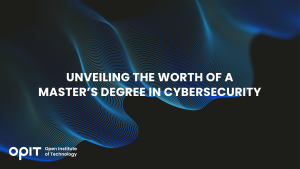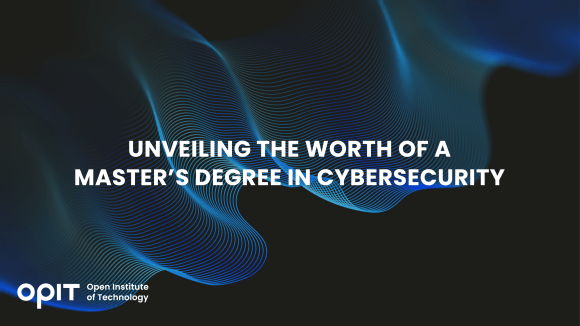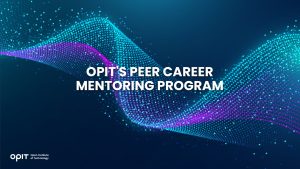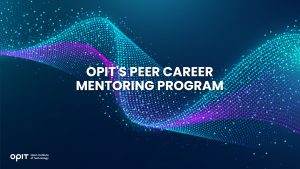

The digital landscape is evolving rapidly, and with so many facets of life moving online, cyber attackers are finding more lucrative ways to exploit them. As such, cybersecurity is more vital than ever before, and the need for professionals in this field will only increase.
So, if you’re wondering, “Is a master’s in cybersecurity worth it?” the short answer is “yes.” For the long answer, read on and learn more about this degree, career paths, and potential challenges in this field of study.
Understanding a Master’s Degree in Cybersecurity
Let’s break down what a cybersecurity degree entails. This degree is the training polygon for the highly sought-after cyber guardians. You’ll learn the art of threat assessment, network security, information assurance, and incident response.
But how difficult is a cyber security degree? It can be challenging but gratifying. The program is structured into rigorous courses that cover the technical aspects of networking, computer science, cryptography, and ethical hacking, along with the big-picture strategies of cybersecurity. The slight learning curve is justified, considering that your job will be to protect sensitive data and vulnerable individuals in the digital sphere.
Analyzing the Degree’s Worth
“Is a master’s degree in cyber security worth it?” Even though the field gets considerable hype, you might still have concerns about the return on investment (ROI). After all, a seemingly lucrative field might not give as much back as you’d hope if it’s overly saturated.
First, jobs with cybersecurity degrees are plentiful, with something for everyone. Businesses, government agencies, and non-profits are on the lookout for cybersecurity professionals who can protect their networks, data, employees, and clients.
Salary potential is equally as solid. A master’s degree in cybersecurity lets you make a grand entrance into the job market. Since professionals are in high demand and the curriculum is challenging, companies are willing to pay handsomely for skilled individuals who can protect their digital assets.
As long as the digital world keeps expanding, so does the need for cybersecurity experts. It’s a field where job security is as solid as the encryption protocols you’ll learn to master. Industries across the board, from finance to healthcare, need experts who can fend off cyber threats, making this degree a passport to a world of opportunities.
Career Pathways With a Cybersecurity Degree
“What can you do with a cybersecurity degree?” is a legitimate and fairly common question. But there are no one-size-fits-all answers here because the field’s career paths are nearly limitless. Below are some examples of potential career paths you can take with this degree.
Cybersecurity Analyst
As a cybersecurity analyst, you will be on the front lines of networks and IT systems as you scour for breaches and threats. Your primary job is to make sure that threats stay out and all data stays safe.
Information Security Manager
As an information security manager, you will have to strategize, oversee security operations, and keep your company’s secrets safe. It’s a role that demands respect and makes a difference for major players in business and governance.
Cybersecurity Consultant
As a consultant, you will be switching from project to project as you offer wisdom on how to ramp up security. You will be the one to guide businesses through digital threats.
Chief Information Security Officer (CISO)
As a Chief Information Security Officer (CISO), you are at the very top of the cybersecurity hierarchy. You’ll have a bird’s-eye view of the cybersecurity landscape, make critical decisions, and lead your organization’s digital defense strategy. It’s a role that’s as prestigious as it sounds.
The Challenges and Rewards of Studying Cybersecurity
The ascent comes with a fair share of steep climbs. The first challenge shows in a slew of technical skills, from coding to network architecture. Cybersecurity specialists also must keep pace with cyber threats that evolve faster than many users can keep up with them.
However, the field is also rewarding. When you hone problem-solving skills, you will tackle innovative projects that push the boundaries of what’s possible, turning theoretical knowledge into real-world deeds. You are the defender of nefarious threats, protecting not just bits and bytes but real people’s lives and livelihoods.
The rewards of a cybersecurity degree stretch far beyond the diploma. The degree means that you are building a toolkit for a meaningful career where, every day, you’re making a tangible difference. The impact of your work echoes far and wide as you patch vulnerabilities and outsmart the latest malware.
OPIT’s Master’s Degree in Cybersecurity
OPIT’s Master’s Degree in Enterprise Cybersecurity covers cybersecurity from beginning to end, starting with the bedrock principles and moving to the cutting-edge techniques that are shaping the future of digital defense. It is in lockstep with industry certifications and real-world scenarios, so you will not be learning in a vacuum or be limited to theory.
OPIT connects you with a cadre of expert faculty with extensive experience, gives you a supportive learning environment, and has hands-on projects that put theory into action. With all these benefits, concerns about the degree’s difficulty will soon melt away.
Choosing OPIT’s program gives you a strategic edge in the highly intense and seemingly chaotic cyber sphere. The curriculum is a comprehensive launchpad for innovation that provides plenty of opportunities to get close and personal with real-world problems. Even when you’re already reaching the end of the road of learning, there’s a robust support system to help you take on the job market, like resume workshops or networking events.
The community is the crowning jewel of the OPIT deal. Stepping into OPIT’s program, you’re joining a network of passionate, like-minded individuals. It’s a place where connections are forged between servers and between real people.
Cybersecurity Is Worth the Effort
Being a cybersecurity specialist is indeed a path that comes with a fair share of challenges—late nights, complex problems, and a steep learning curve. But the rewards are high-demand careers, attractive salaries, and the satisfaction of being on the digital frontlines.
OPIT’s Master’s Degree in Enterprise Cybersecurity is a beacon for those ready to give this field a try. It boasts expert faculty, a supportive environment, and hands-on learning that bridges the gap between theory and practice. The vibrant community and networking opportunities will propel your career forward.
Related posts

Source:
- Raconteur, published on November 06th, 2025
Many firms have conducted successful Artificial Intelligence (AI) pilot projects, but scaling them across departments and workflows remains a challenge. Inference costs, data silos, talent gaps and poor alignment with business strategy are just some of the issues that leave organisations trapped in pilot purgatory. This inability to scale successful experiments means AI’s potential for improving enterprise efficiency, decision-making and innovation isn’t fully realised. So what’s the solution?
Although it’s not a magic bullet, an AI operating model is really the foundation for scaling pilot projects up to enterprise-wide deployments. Essentially it’s a structured framework that defines how the organisation develops, deploys and governs AI. By bringing together infrastructure, data, people, and governance in a flexible and secure way, it ensures that AI delivers value at scale while remaining ethical and compliant.
“A successful AI proof-of-concept is like building a single race car that can go fast,” says Professor Yu Xiong, chair of business analytics at the UK-based Surrey Business School. “An efficient AI technology operations model, however, is the entire system – the processes, tools, and team structures – for continuously manufacturing, maintaining, and safely operating an entire fleet of cars.”
But while the importance of this framework is clear, how should enterprises establish and embed it?
“It begins with a clear strategy that defines objectives, desired outcomes, and measurable success criteria, such as model performance, bias detection, and regulatory compliance metrics,” says Professor Azadeh Haratiannezhadi, co-founder of generative AI company Taktify and professor of generative AI in cybersecurity at OPIT – the Open Institute of Technology.
Platforms, tools and MLOps pipelines that enable models to be deployed, monitored and scaled in a safe and efficient way are also essential in practical terms.
“Tools and infrastructure must also be selected with transparency, cost, and governance in mind,” says Efrain Ruh, continental chief technology officer for Europe at Digitate. “Crucially, organisations need to continuously monitor the evolving AI landscape and adapt their models to new capabilities and market offerings.”
An open approach
The most effective AI operating models are also founded on openness, interoperability and modularity. Open source platforms and tools provide greater control over data, deployment environments and costs, for example. These characteristics can help enterprises to avoid vendor lock-in, successfully align AI to business culture and values, and embed it safely into cross-department workflows.
“Modularity and platformisation…avoids building isolated ‘silos’ for each project,” explains professor Xiong. “Instead, it provides a shared, reusable ‘AI platform’ that integrates toolchains for data preparation, model training, deployment, monitoring, and retraining. This drastically improves efficiency and reduces the cost of redundant work.”
A strong data strategy is equally vital for ensuring high-quality performance and reducing bias. Ideally, the AI operating model should be cloud and LLM agnostic too.
“This allows organisations to coordinate and orchestrate AI agents from various sources, whether that’s internal or 3rd party,” says Babak Hodjat, global chief technology officer of AI at Cognizant. “The interoperability also means businesses can adopt an agile iterative process for AI projects that is guided by measuring efficiency, productivity, and quality gains, while guaranteeing trust and safety are built into all elements of design and implementation.”
A robust AI operating model should feature clear objectives for compliance, security and data privacy, as well as accountability structures. Richard Corbridge, chief information officer of Segro, advises organisations to: “Start small with well-scoped pilots that solve real pain points, then bake in repeatable patterns, data contracts, test harnesses, explainability checks and rollback plans, so learning can be scaled without multiplying risk. If you don’t codify how models are approved, deployed, monitored and retired, you won’t get past pilot purgatory.”
Of course, technology alone can’t drive successful AI adoption at scale: the right skills and culture are also essential for embedding AI across the enterprise.
“Multidisciplinary teams that combine technical expertise in AI, security, and governance with deep business knowledge create a foundation for sustainable adoption,” says Professor Haratiannezhadi. “Ongoing training ensures staff acquire advanced AI skills while understanding associated risks and responsibilities.”
Ultimately, an AI operating model is the playbook that enables an enterprise to use AI responsibly and effectively at scale. By drawing together governance, technological infrastructure, cultural change and open collaboration, it supports the shift from isolated experiments to the kind of sustainable AI capability that can drive competitive advantage.
In other words, it’s the foundation for turning ambition into reality, and finally escaping pilot purgatory for good.

The Open Institute of Technology (OPIT) is the perfect place for those looking to master the core skills and gain the fundamental knowledge they need to enter the exciting and dynamic environment of the tech industry. While OPIT’s various degrees and courses unlock the doors to numerous careers, students may not know exactly which line of work they wish to enter, or how, exactly, to take the next steps.
That’s why, as well as providing exceptional online education in fields like Responsible AI, Computer Science, and Digital Business, OPIT also offers an array of career-related services, like the Peer Career Mentoring Program. Designed to provide the expert advice and support students need, this program helps students and alumni gain inspiration and insight to map out their future careers.
Introducing the OPIT Peer Career Mentoring Program
As the name implies, OPIT’s Peer Career Mentoring Program is about connecting students and alumni with experienced peers to provide insights, guidance, and mentorship and support their next steps on both a personal and professional level.
It provides a highly supportive and empowering space in which current and former learners can receive career-related advice and guidance, harnessing the rich and varied experiences of the OPIT community to accelerate growth and development.
Meet the Mentors
Plenty of experienced, expert mentors have already signed up to play their part in the Peer Career Mentoring Program at OPIT. They include managers, analysts, researchers, and more, all ready and eager to share the benefits of their experience and their unique perspectives on the tech industry, careers in tech, and the educational experience at OPIT.
Examples include:
- Marco Lorenzi: Having graduated from the MSc in Applied Data Science and AI program at OPIT, Marco has since progressed to a role as a Prompt Engineer at RWS Group and is passionate about supporting younger learners as they take their first steps into the workforce or seek career evolution.
- Antonio Amendolagine: Antonio graduated from the OPIT MSc in Applied Data Science and AI and currently works as a Product Marketing and CRM Manager with MER MEC SpA, focusing on international B2B businesses. Like other mentors in the program, he enjoys helping students feel more confident about achieving their future aims.
- Asya Mantovani: Asya took the MSc in Responsible AI program at OPIT before taking the next steps in her career as a Software Engineer with Accenture, one of the largest IT companies in the world, and a trusted partner of the institute. With a firm belief in knowledge-sharing and mutual support, she’s eager to help students progress and succeed.
The Value of the Peer Mentoring Program
The OPIT Peer Career Mentoring Program is an invaluable source of support, inspiration, motivation, and guidance for the many students and graduates of OPIT who feel the need for a helping hand or guiding light to help them find the way or make the right decisions moving forward. It’s a program built around the sharing of wisdom, skills, and insights, designed to empower all who take part.
Every student is different. Some have very clear, fixed, and firm objectives in mind for their futures. Others may have a slightly more vague outline of where they want to go and what they want to do. Others live more in the moment, focusing purely on the here and now, but not thinking too far ahead. All of these different types of people may need guidance and support from time to time, and peer mentoring provides that.
This program is also just one of many ways in which OPIT bridges the gaps between learners around the world, creating a whole community of students and educators, linked together by their shared passions for technology and development. So, even though you may study remotely at OPIT, you never need to feel alone or isolated from your peers.
Additional Career Services Offered by OPIT
The Peer Career Mentoring Program is just one part of the larger array of career services that students enjoy at the Open Institute of Technology.
- Career Coaching and Support: Students can schedule one-to-one sessions with the institute’s experts to receive insightful feedback, flexibly customized to their exact needs and situation. They can request resume audits, hone their interview skills, and develop action plans for the future, all with the help of experienced, expert coaches.
- Resource Hub: Maybe you need help differentiating between various career paths, or seeing where your degree might take you. Or you need a bit of assistance in handling the challenges of the job-hunting process. Either way, the OPIT Resource Hub contains the in-depth guides you need to get ahead and gain practical skills to confidently move forward.
- Career Events: Regularly, OPIT hosts online career event sessions with industry experts and leaders as guest speakers about the topics that most interest today’s tech students and graduates. You can join workshops to sharpen your skills and become a better prospect in the job market, or just listen to the lessons and insights of the pros.
- Internship Opportunities: There are few better ways to begin your professional journey than an internship at a top-tier company. OPIT unlocks the doors to numerous internship roles with trusted institute partners, as well as additional professional and project opportunities where you can get hands-on work experience at a high level.
In addition to the above, OPIT also teams up with an array of leading organizations around the world, including some of the biggest names, including AWS, Accenture, and Hype. Through this network of trust, OPIT facilitates students’ steps into the world of work.
Start Your Study Journey Today
As well as the Peer Career Mentoring Program, OPIT provides numerous other exciting advantages for those who enroll, including progressive assessments, round-the-clock support, affordable rates, and a team of international professors from top universities with real-world experience in technology. In short, it’s the perfect place to push forward and get the knowledge you need to succeed.
So, if you’re eager to become a tech leader of tomorrow, learn more about OPIT today.
Have questions?
Visit our FAQ page or get in touch with us!
Write us at +39 335 576 0263
Get in touch at hello@opit.com
Talk to one of our Study Advisors
We are international
We can speak in:


